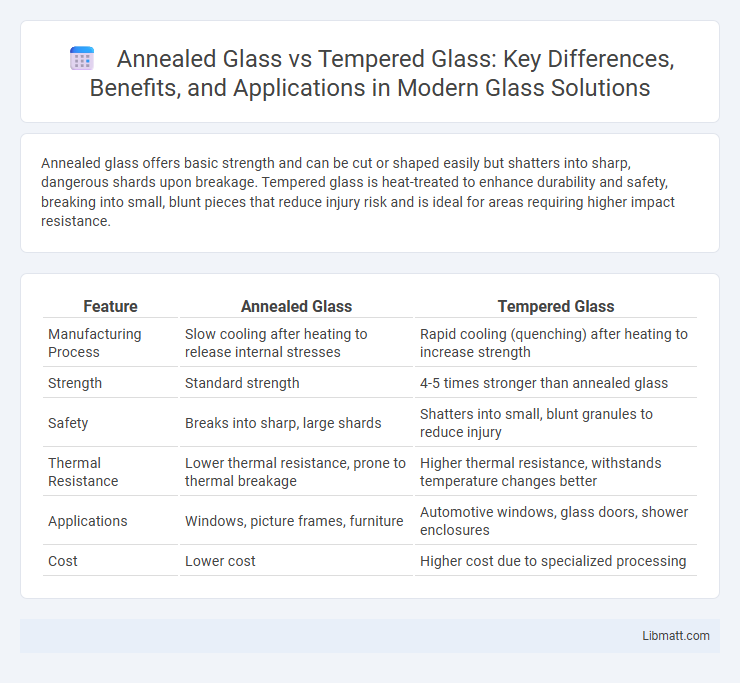Annealed glass offers basic strength and can be cut or shaped easily but shatters into sharp, dangerous shards upon breakage. Tempered glass is heat-treated to enhance durability and safety, breaking into small, blunt pieces that reduce injury risk and is ideal for areas requiring higher impact resistance.
Table of Comparison
| Feature | Annealed Glass | Tempered Glass |
|---|---|---|
| Manufacturing Process | Slow cooling after heating to release internal stresses | Rapid cooling (quenching) after heating to increase strength |
| Strength | Standard strength | 4-5 times stronger than annealed glass |
| Safety | Breaks into sharp, large shards | Shatters into small, blunt granules to reduce injury |
| Thermal Resistance | Lower thermal resistance, prone to thermal breakage | Higher thermal resistance, withstands temperature changes better |
| Applications | Windows, picture frames, furniture | Automotive windows, glass doors, shower enclosures |
| Cost | Lower cost | Higher cost due to specialized processing |
Introduction to Annealed and Tempered Glass
Annealed glass is produced by slowly cooling molten glass, resulting in a material that is clear but relatively fragile and susceptible to breakage into sharp shards. Tempered glass undergoes a rapid heating and cooling process that increases its strength, making it up to five times stronger than annealed glass and causing it to break into small, blunt pieces for safety. Understanding these differences is crucial for selecting the right type of glass for your windows, doors, or other applications where strength and safety are priorities.
Understanding the Manufacturing Processes
Annealed glass is produced by slowly cooling molten glass in a controlled environment, which relieves internal stresses and results in a smooth, clear pane suitable for general use. Tempered glass undergoes a rapid heating process followed by sudden cooling, creating a surface compression that significantly increases its strength and causes it to shatter into small, less harmful pieces upon impact. Understanding these manufacturing differences helps determine the best choice for your safety and application needs.
Physical Properties: Strength and Durability
Annealed glass has lower strength and durability compared to tempered glass, making it more prone to breakage under impact or thermal stress. Tempered glass undergoes heat treatment, which increases its strength up to four times that of annealed glass and causes it to shatter into small, less harmful pieces when broken. Your choice between these two types depends on the safety and performance requirements of your project.
Safety Features and Performance
Tempered glass offers superior safety features due to its ability to shatter into small, blunt pieces upon impact, reducing injury risks, while annealed glass breaks into large, sharp shards that pose greater hazards. Performance-wise, tempered glass withstands higher stress and thermal variations, making it ideal for applications requiring durability and impact resistance. Your choice between annealed and tempered glass should consider the level of safety and performance needed for specific environments like automotive, architectural, or home use.
Visual Differences and Aesthetic Considerations
Annealed glass offers superior optical clarity with minimal distortion, making it ideal for applications where visual aesthetics are crucial, such as picture frames or storefronts. Tempered glass, while slightly less clear due to its thermal treatment, provides enhanced safety and strength but may exhibit minor rippling or waviness under certain lighting conditions. Your choice between annealed and tempered glass will balance visual perfection against durability and safety needs.
Common Applications in Architecture and Design
Tempered glass is widely used in architecture and design for safety-critical applications such as windows, doors, and facades due to its high strength and shatter-resistant properties. Annealed glass, favored for its cost-effectiveness and clarity, is commonly applied in interior partitions, picture frames, and decorative elements where impact resistance is less critical. Your choice between annealed and tempered glass depends on the specific safety requirements and functional demands of the architectural project.
Cost Comparison: Annealed vs Tempered Glass
Annealed glass generally costs less than tempered glass due to its simpler manufacturing process and lower safety standards. Tempered glass undergoes heat treatment to enhance strength and safety, which increases production expenses and market price. Choosing between annealed and tempered glass depends on your budget and the required safety specifications for your project.
Installation Methods and Requirements
Annealed glass requires careful handling during installation to avoid stress points, often needing cushioning materials and slow, controlled setting to prevent breakage. Tempered glass, being stronger and more resistant to impact, allows for more straightforward installation but necessitates precise measurements beforehand, as alterations after tempering are impossible. You must ensure that tempered glass fits perfectly within frames or supports to maintain safety and performance standards.
Building Codes and Regulatory Standards
Tempered glass complies with strict building codes such as ASTM C1048 and ANSI Z97.1 due to its enhanced strength and safety features, making it mandatory for use in hazardous locations like doors and windows. Annealed glass meets fewer regulatory requirements and is generally restricted to non-safety applications in construction.
Choosing the Right Glass for Your Project
Annealed glass offers clarity and ease of cutting, making it ideal for applications where intricate shapes or custom designs are required, but it is more prone to breakage under impact. Tempered glass provides enhanced strength and safety by undergoing a heat-treatment process that increases resistance to thermal stress and shattering, suitable for areas with higher safety standards such as doors, windows, and facades. Selecting between annealed and tempered glass depends on balancing factors like structural requirements, safety codes, and cost-effectiveness for the specific project's functional demands.
Annealed glass vs tempered glass Infographic

 libmatt.com
libmatt.com